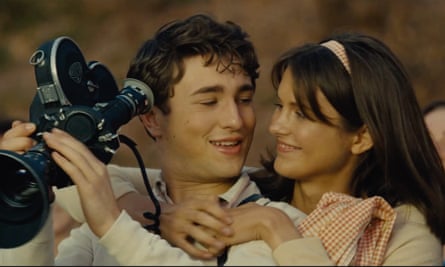The Fabelmans will never be fought over like Tár, but it has far more to say about the joy of art | Charlotte Higgins
Written by on January 29, 2023
For a film that has, if you want to be blunt about it, tanked at the box office, Tár has provoked a disproportionate amount of conversation. It’s possible that the discourse around the film – about a powerful, highly successful and extremely problematic conductor called Lydia Tár, played by Cate Blanchett – is as interesting as the film itself.
I’ve heard multiple, conflicting interpretations of Tár: that it’s a disgraceful misrepresentation of the field of classical music; that it’s all too real; that it’s all too surreal; that it carries an intellectual heft that is rare at the movies; that it’s not half as clever as it thinks it is; that it’s not about conducting, it’s about power; that it’s not about power, it’s about narcissism; that it’s about a clash of ethics between the generations; that it’s about third-wave feminism; that its central character, in all her “unlikeability”, is arrestingly complex; that its central character is irredeemably hateful; that it’s a fascinating, even-handed anatomisation of “cancel culture”; that it is actually a “regressive” movie that takes “bitter aim” at identity politics. Then there is an extensive online debate devoted to decoding its eerie final act. There’s something exciting about a film that is such an open text, that demands so much discussion.
It is not unproblematic, though. The classical music world is talking about Tár, and not in a good way. (A leading London conservatoire, for example, politely declined to host the UK premiere.) The anxiety derives, not least, from the fact that the biography of the central character bears more than a passing resemblance to that of conductor Marin Alsop. Like Tár she is American, was mentored by Leonard Bernstein, is a lesbian, is partner to and co-parent with a sometime orchestral player, and created a foundation for early-career female conductors. Alsop herself has criticised the film, and I have some sympathy with her. Tár, among other things, is a bully and an abuser, and Alsop is not. Her wider point, though, is that a tiny handful of women have struggled to push through into big roles in conducting. Of those who have “made it”, some are, for sure, pleasanter and better behaved than others. But of them, literally none are moulded like the fictional Tár. The kind of abuse committed by Tár – blackballing, using power to extract sex – is unhappily present in classical music, but the perpetrators, known largely by rumour and word-of-mouth rather than, yet, by open accusation, are men. Women in classical music may be bullies and behave appallingly. But none to my knowledge has allegations of abuse hovering over them of the kind that, for example, resulted in the firing of the late James Levine from his post at the Metropolitan Opera.
The counter-argument to this perspective is that the film isn’t really “about” classical music in any meaningful way, and that its setting is incidental to its purpose. But that would be to overlook the fact that the film does, in fact, want to tell us something about art, and artworks about art often have an intriguing meta-narrative to tell. Consider other films set in the world of classical music, or adjacent to it. There’s Amadeus, of course; Michael Haneke’s The Piano Teacher, François Truffaut’s Shoot the Piano Player, Denis Dercourt’s The Page Turner, the Du Pré biopic, Hilary and Jackie, Shine, A Late Quartet (memorably with Philip Seymour Hoffman as an embittered second violinist). What do they have in common? Here’s a clue: the main characters in George Cukor’s Gaslight – the film that has given its name to a whole form of abuse – are an aspiring opera singer and a pianist.
Not all of these films are about abuse and violence, but all of them deal, in one way or another, with obsession and mental illness. I can’t escape the notion that for film-makers, classical music offers a means of representing some of their darkest, most twisted thoughts about art and creativity. In a way, one can see why: of all the corners of the interlocking artistic worlds, classical music, along with ballet, requires the most rarefied, intense form of lifelong commitment. It offers to creators of fiction an extreme version of artmaking.
Films about cinema, by contrast, tend to be coloured by nostalgia or sentimentality (think of La La Land, or Sam Mendes’ new Empire of Light). Steven Spielberg’s latest film, The Fabelmans, co-written with Tony Kushner, has a little of both: it is, really, Spielberg’s own Bildungsroman, even origin myth, and – of course! – there is an early moment in which the main character, Sam, goes to the cinema for the first time as a child. Naturally, we see the reflected light from the screen play over his face; naturally, by these means, the flicks indelibly work their sorcery on him.

The Fabelmans is much more interesting than this description suggests, and, like Tár, it has something to say about power, in this case that which is invested in the bearer of the movie camera – the unwilling holder of secrets, the hero-maker, the manipulator. Classical music is also invoked in the movie, through Sam’s mother, a thwarted pianist, and again it occupies that familiar thematic territory of loss and mental illness. The Fabelmans, however, is touching and accurate on what art actually is, and feels like, and consists of. There’s a lovely hint of this in its punning nomenclature: the name Spielberg is reminiscent of the German or Yiddish for “play”; the word Fabelman of the word for “story”. In this movie, stories arise out of play: there is a clear line from Sam’s first films, made for fun with his fellow boy scouts, to the work for which the real Spielberg is known.
Joy, playfulness: these are qualities entirely absent from the vision of art presented by Todd Field’s Tár, perhaps deliberately. Lydia Tár is a dictator – a model of power for conductors that is in steep decline, and, in fact, largely out of reach for women, heavily predicated as it is on traditionally male patterns of authority. Most encounters between conductors and orchestral musicians actually operate, at their best, through collaboration and, yes, playfulness; conductors tend rather to use persuasiveness and charm than blunt command to bring forward their ideas. The balance of power is not wholly on conductors’ side: orchestral players can be pitiless to conductors they do not respect.
There’s one film I have not mentioned that is about conductors and composers, and also ballet: Powell and Pressburger’s The Red Shoes (1948). Here too there is abuse, and obsession, and mental illness. Like The Fabelmans, like Tár, it suggests that art and domestic life may be impossible to reconcile. But unlike Tár, amid its darkness, it offers a joyous image of what it is to love art, be an artist, to be part of a company of performers. Unlike Tár, which invokes, rather than has anything particularly interesting to say about Mahler, The Red Shoes contains a strange and lovely artwork in itself in the form of the ballet-within-the-film that is also called The Red Shoes. It’s a film that has made generations of impressionable youngsters grow up into artists. Will Tár ever have that galvanising effect? Discuss.
watch avatar the way of water full movie
watch avatar the way of water full movie
watch avatar the way of water full movie






